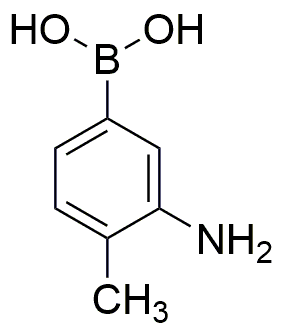3-Amino-4-methylphenylboronic acid is widely utilized in research focused on:
- Drug Development: This compound serves as a key building block in the synthesis of various pharmaceuticals, particularly in developing targeted therapies for cancer and other diseases.
- Bioconjugation: Its boronic acid functionality allows for the selective binding to diols, making it valuable in creating bioconjugates for drug delivery systems and diagnostic applications.
- Organic Electronics: It is used in the fabrication of organic semiconductors, contributing to the development of efficient electronic devices, such as organic light-emitting diodes (OLEDs).
- Material Science: The compound is utilized in creating advanced materials with specific properties, such as enhanced thermal stability and mechanical strength, beneficial for various industrial applications.
- Analytical Chemistry: It plays a role in the development of sensors and assays for detecting biomolecules, providing a reliable method for monitoring biological processes.
General Information
Properties
Safety and Regulations
Applications
3-Amino-4-methylphenylboronic acid is widely utilized in research focused on:
- Drug Development: This compound serves as a key building block in the synthesis of various pharmaceuticals, particularly in developing targeted therapies for cancer and other diseases.
- Bioconjugation: Its boronic acid functionality allows for the selective binding to diols, making it valuable in creating bioconjugates for drug delivery systems and diagnostic applications.
- Organic Electronics: It is used in the fabrication of organic semiconductors, contributing to the development of efficient electronic devices, such as organic light-emitting diodes (OLEDs).
- Material Science: The compound is utilized in creating advanced materials with specific properties, such as enhanced thermal stability and mechanical strength, beneficial for various industrial applications.
- Analytical Chemistry: It plays a role in the development of sensors and assays for detecting biomolecules, providing a reliable method for monitoring biological processes.
Documents
Safety Data Sheets (SDS)
The SDS provides comprehensive safety information on handling, storage, and disposal of the product.
Product Specification (PS)
The PS provides a comprehensive breakdown of the product’s properties, including chemical composition, physical state, purity, and storage requirements. It also details acceptable quality ranges and the product's intended applications.
Certificates of Analysis (COA)
Search for Certificates of Analysis (COA) by entering the products Lot Number. Lot and Batch Numbers can be found on a product’s label following the words ‘Lot’ or ‘Batch’.
*Catalog Number
*Lot Number
Certificates Of Origin (COO)
This COO confirms the country where the product was manufactured, and also details the materials and components used in it and whether it is derived from natural, synthetic, or other specific sources. This certificate may be required for customs, trade, and regulatory compliance.
*Catalog Number
*Lot Number
Safety Data Sheets (SDS)
The SDS provides comprehensive safety information on handling, storage, and disposal of the product.
DownloadProduct Specification (PS)
The PS provides a comprehensive breakdown of the product’s properties, including chemical composition, physical state, purity, and storage requirements. It also details acceptable quality ranges and the product's intended applications.
DownloadCertificates of Analysis (COA)
Search for Certificates of Analysis (COA) by entering the products Lot Number. Lot and Batch Numbers can be found on a product’s label following the words ‘Lot’ or ‘Batch’.
*Catalog Number
*Lot Number
Certificates Of Origin (COO)
This COO confirms the country where the product was manufactured, and also details the materials and components used in it and whether it is derived from natural, synthetic, or other specific sources. This certificate may be required for customs, trade, and regulatory compliance.


